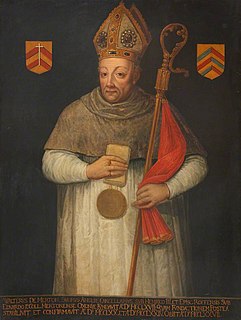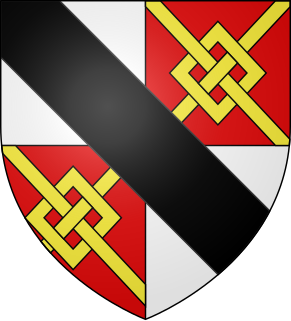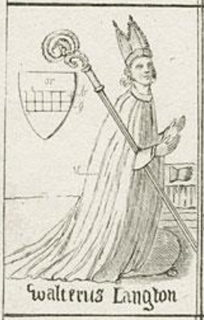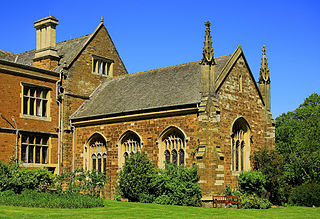Related Research Articles

Walter de Merton was Lord Chancellor of England, Archdeacon of Bath, founder of Merton College, Oxford, and Bishop of Rochester. For the first two years of the reign of Edward I he was - in all but name - Regent of England during the King's absence abroad. He died in 1277 after falling from his horse, and is buried in Rochester Cathedral.

Roger Mortimer, 1st Baron Mortimer, of Wigmore Castle in Herefordshire, was a marcher lord who was a loyal ally of King Henry III of England and at times an enemy, at times an ally, of Llywelyn ap Gruffudd, Prince of Wales.

Hugh le Despenser, 1st Baron le Despenser was an important ally of Simon de Montfort during the reign of Henry III. He served briefly as Justiciar of England in 1260 and as Constable of the Tower of London.

Walter Langton of Castle Ashby in Northamptonshire, was Bishop of Coventry and Lichfield and Treasurer of England. The life of Langton was strongly influenced by his uncle William Langton (d.1279), Archbishop of York-elect, by Robert Burnell, Lord Chancellor of England and then by the years in which he served King Edward I. Lichfield Cathedral was improved and enriched at his expense.
Gilbert Segrave was a medieval Bishop of London. He was the son of Nicholas Segrave, 1st Baron Segrave.

John Grey, 2nd Baron Grey of Wilton was an English nobleman and administrator.
Ralph Basset was a medieval English royal justice during the reign of King Henry I of England. He was a native of Normandy, and may have come to Henry's notice while Henry held land in Normandy prior to becoming king. Basset is first mentioned in documents about 1102, and from then until his death around 1127, he was frequently employed as a royal justice. His son Richard Basset also became a royal judge.
Richard Basset was a royal judge and sheriff during the reign of King Henry I of England. His father was also a royal justice. In about 1122 Basset married the eventual heiress of another justice; the marriage settlement has survived. In 1129–30 Basset was co-sheriff of eleven counties. Basset and his wife founded a monastic house in 1125 from their lands, which before the donation were equivalent to 15 knight's fees.
Edmund de Stafford, 1st Baron Stafford (1272/3-1308), was the son of Nicholas de Stafford, who was summoned to parliament by writ on 6 February 1299 by King Edward I.

Launde Priory is a former Augustinian priory in Leicestershire, England. Its successor Launde Abbey is used as a conference and retreat centre by the Church of England dioceses of Leicester and Peterborough.
William Bardolf, was an English baronial leader.
William Basset was an Anglo-Norman administrator and justice.

Members of the Basset family were amongst the early Norman settlers in the Kingdom of England. It is currently one of the few ancient English families that has survived through the centuries in the paternal line. They originated at Montreuil-au-Houlme in the Duchy of Normandy.
Ralph Basset, was an English baronial leader.
Ralph Basset was an English royal justice.
Ralph Basset, 1st Baron Basset of Drayton Bassett in Staffordshire, was an English nobleman who fought in both the Anglo-French War and in the First War of Scottish Independence. He was the son of one of Simon de Montfort's barons, Ralph Basset (d.1265), and Margaret de Somery. In 1291, he was made Governor of Edinburgh Castle. He was created 1st Baron Basset of Drayton in 1295.
Philip Marmion, 5th and last Baron Marmion of Tamworth was King's Champion and Sheriff. He was descended from the lords of Fontenay-le-Marmion in Normandy, who are said to have been hereditary champions of the Dukes of Normandy.
Baron Basset of Drayton of Drayton in the county of Stafford was a title in the Peerage of England.

Sir Ralph Basset, 2nd Baron Basset of Drayton was a 13th-14th century English nobleman who fought in both the Anglo-French War and in the First War of Scottish Independence.

William de Ferrers (1240-1287) of Groby Castle in Leicestershire was the younger son of William de Ferrers, 5th Earl of Derby (c.1193-1254) of Chartley Castle in Staffordshire, by his second wife Margaret de Quincy, daughter and heiress of Roger de Quincy, 2nd Earl of Winchester (c.1195-1264). He founded the line of Ferrers of Groby, having been given Groby Castle by his mother Margaret de Quincy. Having rebelled against King Henry III, he was taken prisoner at the Battle of Northampton in 1264, but was later pardoned. In 1282 He was with King Edward I in the Army of Wales.
References
![]() This article incorporates text from a publication now in the public domain : "Basset, Ralph (d.1282?)". Dictionary of National Biography . London: Smith, Elder & Co. 1885–1900.
This article incorporates text from a publication now in the public domain : "Basset, Ralph (d.1282?)". Dictionary of National Biography . London: Smith, Elder & Co. 1885–1900.